(All information courtesy of the instrument teams.)
![]() Previous IAU Circulars
Previous IAU Circulars
TITLE: GCN/SWIFT NOTICE
NOTICE_DATE: Sun 31 Jan 16 08:22:46 UT
NOTICE_TYPE: Swift-BAT GRB Position
TRIGGER_NUM: 672236, Seg_Num: 0
GRB_RA: 78.182d {+05h 12m 44s} (J2000),
78.377d {+05h 13m 30s} (current),
77.575d {+05h 10m 18s} (1950)
GRB_DEC: -7.067d {-07d 04' 02"} (J2000),
-7.049d {-07d 02' 57"} (current),
-7.126d {-07d 07' 32"} (1950)
GRB_ERROR: 3.00 [arcmin radius, statistical only]
GRB_INTEN: 2840 [cnts] Image_Peak=134 [image_cnts]
TRIGGER_DUR: 1.024 [sec]
TRIGGER_INDEX: 146 E_range: 25-100 keV
BKG_INTEN: 17546 [cnts]
BKG_TIME: 30016.22 SOD {08:20:16.22} UT
BKG_DUR: 8 [sec]
GRB_DATE: 17418 TJD; 31 DOY; 16/01/31
GRB_TIME: 30031.96 SOD {08:20:31.96} UT
GRB_PHI: -93.02 [deg]
GRB_THETA: 23.77 [deg]
SOLN_STATUS: 0x20000003
RATE_SIGNIF: 11.66 [sigma]
IMAGE_SIGNIF: 7.32 [sigma]
MERIT_PARAMS: +1 +0 +0 +0 +2 -3 +0 +0 +50 +0
SUN_POSTN: 313.34d {+20h 53m 21s} -17.50d {-17d 29' 58"}
SUN_DIST: 120.43 [deg] Sun_angle= -8.3 [hr] (East of Sun)
MOON_POSTN: 211.12d {+14h 04m 29s} -9.08d {-09d 04' 32"}
MOON_DIST: 130.23 [deg]
MOON_ILLUM: 58 [%]
GAL_COORDS: 207.90,-25.14 [deg] galactic lon,lat of the burst (or transient)
ECL_COORDS: 76.43,-29.95 [deg] ecliptic lon,lat of the burst (or transient)
COMMENTS: SWIFT-BAT GRB Coordinates.
COMMENTS: This Notice was delayed by more than 60 sec past the end of the trigger integration interval;
COMMENTS: probably due to it occurring during a Malindi downlink session.
COMMENTS: This is a rate trigger.
COMMENTS: A point_source was found.
COMMENTS: This does not match any source in the on-board catalog.
COMMENTS: This does not match any source in the ground catalog.
COMMENTS: This is a GRB.
COMMENTS: This trigger occurred at longitude,latitude = 179.52,8.55 [deg].
COMMENTS:
COMMENTS: NOTE: This BAT event is temporally(5.0<100sec) coincident with the INTEGRAL_SPIACS event (trignum=7353).
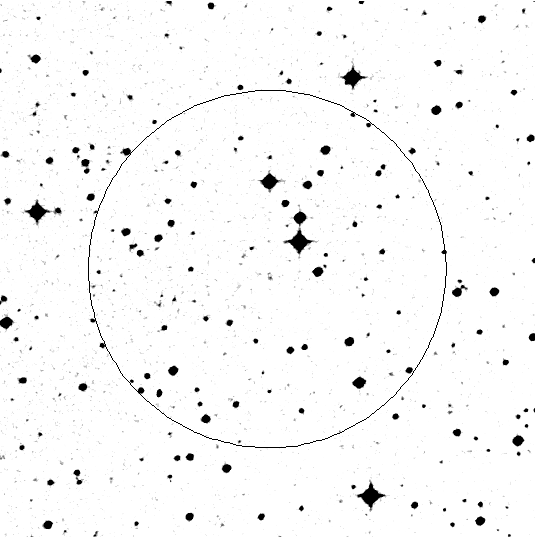
TITLE: GCN/INTEGRAL NOTICE
NOTICE_DATE: Sun 31 Jan 16 08:21:51 UT
NOTICE_TYPE: INTEGRAL SPI ACS Trigger
TRIGGER_NUM: 7353, Sub_Num: 0
GRB_INTEN: 9.02 [sigma]
GRB_TIME: 30036.92 SOD {08:20:36.92} UT
GRB_DATE: 17418 TJD; 31 DOY; 16/01/31
COMMENTS: INTEGRAL SPI_ACS GRB Trigger.
COMMENTS: Time_Scale=2.0000 and Time_Error=1.0000.
COMMENTS: The SPIACS lightcurve can be found at:
COMMENTS: ftp://isdcarc.unige.ch/arc/FTP/ibas/spiacs/2016-01/2016-01-31T08-20-36.7733-03088-15248-0.lc
TITLE: GCN/SWIFT NOTICE
NOTICE_DATE: Sun 31 Jan 16 08:23:31 UT
NOTICE_TYPE: Swift-XRT Position
TRIGGER_NUM: 672236, Seg_Num: 0
GRB_RA: 78.1700d {+05h 12m 40.80s} (J2000),
78.3652d {+05h 13m 27.65s} (current),
77.5633d {+05h 10m 15.18s} (1950)
GRB_DEC: -7.0489d {-07d 02' 56.0"} (J2000),
-7.0307d {-07d 01' 50.4"} (current),
-7.1074d {-07d 06' 26.7"} (1950)
GRB_ERROR: 4.7 [arcsec radius, statistical plus systematic, 90% containment]
GRB_INTEN: 1.29e-08 [erg/cm2/sec]
GRB_SIGNIF: 16.21 [sigma]
IMG_START_DATE: 17418 TJD; 31 DOY; 16/01/31
IMG_START_TIME: 30101.68 SOD {08:21:41.68} UT, 69.7 [sec] since BAT Trigger Time
TAM[0-3]: 327.66 237.22 261.68 243.63
AMPLIFIER: 2
WAVEFORM: 134
SUN_POSTN: 313.34d {+20h 53m 21s} -17.50d {-17d 29' 58"}
SUN_DIST: 120.43 [deg] Sun_angle= -8.3 [hr] (East of Sun)
MOON_POSTN: 211.13d {+14h 04m 31s} -9.08d {-09d 04' 38"}
MOON_DIST: 130.25 [deg]
MOON_ILLUM: 58 [%]
GAL_COORDS: 207.87,-25.14 [deg] galactic lon,lat of the burst
ECL_COORDS: 76.42,-29.93 [deg] ecliptic lon,lat of the burst
COMMENTS: SWIFT-XRT Coordinates.
COMMENTS: The XRT position is 1.31 arcmin from the BAT position.
COMMENTS: The object found at this position is either a very bright burst or a cosmic ray hit.
COMMENTS: Examine the XRT Image to differentiate (CRs are much more compact); see examples at:
COMMENTS: http://www.swift.psu.edu/xrt/XRT_Postage_Stamp_Image_Photo_Gallery.htm .
TITLE: GCN/SWIFT NOTICE
NOTICE_DATE: Sun 31 Jan 16 08:23:41 UT
NOTICE_TYPE: Swift-XRT Image
TRIGGER_NUM: 672236, Seg_Num: 0
GRB_RA: 78.1700d {+05h 12m 40.8s} (J2000),
78.3652d {+05h 13m 27.6s} (current),
77.5633d {+05h 10m 15.1s} (1950)
GRB_DEC: -7.0489d {-07d 02' 56.0"} (J2000),
-7.0307d {-07d 01' 50.4"} (current),
-7.1074d {-07d 06' 26.7"} (1950)
GRB_ERROR: 4.7 [arcsec, radius, statistical plus systematic]
GRB_INTEN: 263 [cnts]
IMG_START_DATE: 17418 TJD; 31 DOY; 16/01/31
IMG_START_TIME: 30101.68 SOD {08:21:41.68} UT, 69.7 [sec] since BAT Trigger Time
CENTROID_X: 259.21, raw= 259 [pixels]
CENTROID_Y: 263.71, raw= 264 [pixels]
ROLL: 244.96 [deg]
GAIN: 4
MODE: 3, Long Image mode
WAVEFORM: 134
EXPO_TIME: 2.50 [sec]
GRB_POS_XRT_Y: -80.35
GRB_POS_XRT_Z: -108.62
IMAGE_URL: sw00672236000msxps_rw.img
SUN_POSTN: 313.34d {+20h 53m 21s} -17.50d {-17d 29' 58"}
SUN_DIST: 120.43 [deg] Sun_angle= -8.3 [hr] (East of Sun)
MOON_POSTN: 211.13d {+14h 04m 31s} -9.08d {-09d 04' 39"}
MOON_DIST: 130.25 [deg]
MOON_ILLUM: 58 [%]
GAL_COORDS: 207.87,-25.14 [deg] galactic lon,lat of the burst
ECL_COORDS: 76.42,-29.93 [deg] ecliptic lon,lat of the burst
COMMENTS: SWIFT-XRT Image.
COMMENTS: The object found at this position is either a very bright burst or a cosmic ray hit.
COMMENTS: Examine the XRT Image to differentiate (CRs are much more compact); see examples at:
COMMENTS: http://www.swift.psu.edu/xrt/XRT_Postage_Stamp_Image_Photo_Gallery.htm .

TITLE: GCN/SWIFT NOTICE
NOTICE_DATE: Sun 31 Jan 16 08:23:47 UT
NOTICE_TYPE: Swift-XRT Processed Image
TRIGGER_NUM: 672236, Seg_Num: 0
GRB_RA: 78.1700d {+05h 12m 40.8s} (J2000),
78.3652d {+05h 13m 27.6s} (current),
77.5633d {+05h 10m 15.1s} (1950)
GRB_DEC: -7.0489d {-07d 02' 56.0"} (J2000),
-7.0307d {-07d 01' 50.4"} (current),
-7.1074d {-07d 06' 26.7"} (1950)
GRB_ERROR: 4.7 [arcsec, radius, statistical plus systematic]
GRB_INTEN: 263 [cnts]
IMG_START_DATE: 17418 TJD; 31 DOY; 16/01/31
IMG_START_TIME: 30101.68 SOD {08:21:41.68} UT, 69.7 [sec] since BAT Trigger Time
CENTROID_X: 259.21, raw= 259 [pixels]
CENTROID_Y: 263.71, raw= 264 [pixels]
ROLL: 244.96 [deg]
GAIN: 4
MODE: 3, Long Image mode
WAVEFORM: 134
EXPO_TIME: 2.50 [sec]
GRB_POS_XRT_Y: -80.35
GRB_POS_XRT_Z: -108.62
IMAGE_URL: sw00672236000msxps_rw.img
SUN_POSTN: 313.34d {+20h 53m 21s} -17.50d {-17d 29' 58"}
SUN_DIST: 120.43 [deg] Sun_angle= -8.3 [hr] (East of Sun)
MOON_POSTN: 211.13d {+14h 04m 31s} -9.08d {-09d 04' 40"}
MOON_DIST: 130.25 [deg]
MOON_ILLUM: 58 [%]
GAL_COORDS: 207.87,-25.14 [deg] galactic lon,lat of the burst
ECL_COORDS: 76.42,-29.93 [deg] ecliptic lon,lat of the burst
COMMENTS: SWIFT-XRT Processed Image.
COMMENTS: The object found at this position is either a very bright burst or a cosmic ray hit.
COMMENTS: Examine the XRT Image to differentiate (CRs are much more compact); see examples at:
COMMENTS: http://www.swift.psu.edu/xrt/XRT_Postage_Stamp_Image_Photo_Gallery.htm .

TITLE: GCN/SWIFT NOTICE
NOTICE_DATE: Sun 31 Jan 16 08:24:35 UT
NOTICE_TYPE: Swift-BAT GRB Lightcurve
TRIGGER_NUM: 672236, Seg_Num: 0
GRB_RA: 78.182d {+05h 12m 44s} (J2000),
78.377d {+05h 13m 30s} (current),
77.575d {+05h 10m 18s} (1950)
GRB_DEC: -7.067d {-07d 04' 02"} (J2000),
-7.049d {-07d 02' 57"} (current),
-7.126d {-07d 07' 32"} (1950)
GRB_DATE: 17418 TJD; 31 DOY; 16/01/31
GRB_TIME: 30031.96 SOD {08:20:31.96} UT
TRIGGER_INDEX: 146
GRB_PHI: -93.02 [deg]
GRB_THETA: 23.77 [deg]
DELTA_TIME: 26.00 [sec]
TRIGGER_DUR: 1.024 [sec]
SOLN_STATUS: 0x3
RATE_SIGNIF: 11.66 [sigma]
IMAGE_SIGNIF: 7.32 [sigma]
LC_URL: sw00672236000msb.lc
SUN_POSTN: 313.34d {+20h 53m 22s} -17.50d {-17d 29' 57"}
SUN_DIST: 120.43 [deg] Sun_angle= -8.3 [hr] (East of Sun)
MOON_POSTN: 211.14d {+14h 04m 33s} -9.08d {-09d 04' 47"}
MOON_DIST: 130.24 [deg]
MOON_ILLUM: 58 [%]
GAL_COORDS: 207.90,-25.14 [deg] galactic lon,lat of the burst (or transient)
ECL_COORDS: 76.43,-29.95 [deg] ecliptic lon,lat of the burst (or transient)
COMMENTS: SWIFT-BAT GRB Lightcurve.
COMMENTS:
COMMENTS: The next comments were copied from the BAT_POS Notice:
COMMENTS: This is a rate trigger.
COMMENTS: A point_source was found.
COMMENTS: This does not match any source in the on-board catalog.
COMMENTS: This does not match any source in the ground catalog.
COMMENTS: This is a GRB.
COMMENTS: This trigger occurred at longitude,latitude = 179.52,8.55 [deg].

TITLE: GCN/SWIFT NOTICE
NOTICE_DATE: Sun 31 Jan 16 08:25:33 UT
NOTICE_TYPE: Swift-UVOT Processed Source List
TRIGGER_NUM: 672236, Seg_Num: 0
POINT_RA: 78.207d {+05h 12m 50s} (J2000)
POINT_DEC: -7.056d {-07d 03' 22"} (J2000)
POINT_ROLL: 244.960d
IMG_START_DATE: 17418 TJD; 31 DOY; 16/01/31
IMG_START_TIME: 30110.49 SOD {08:21:50.49} UT, 78.5 [sec] since BAT Trigger Time
FILTER: 10, White
BKG_MEAN: 2.322
N_STARS: 49
X_OFFSET: 672 [pixels]
Y_OFFSET: 456 [pixels]
X_MAX: 1631 [pixels]
Y_MAX: 1415 [pixels]
DET_THRESH: 13
PHOTO_THRESH: 6
SL_URL: sw00672236000msufc0078.fits
SUN_POSTN: 313.34d {+20h 53m 22s} -17.50d {-17d 29' 56"}
SUN_DIST: 120.46 [deg] Sun_angle= -8.3 [hr] (East of Sun)
MOON_POSTN: 211.14d {+14h 04m 35s} -9.08d {-09d 04' 54"}
MOON_DIST: 130.23 [deg]
MOON_ILLUM: 58 [%]
GAL_COORDS: 207.90,-25.11 [deg] galactic lon,lat of the pointing direction
ECL_COORDS: 76.46,-29.94 [deg] ecliptic lon,lat of the pointing direction
COMMENTS: SWIFT-UVOT Processed Source List.
COMMENTS: All 4 attachments are included.
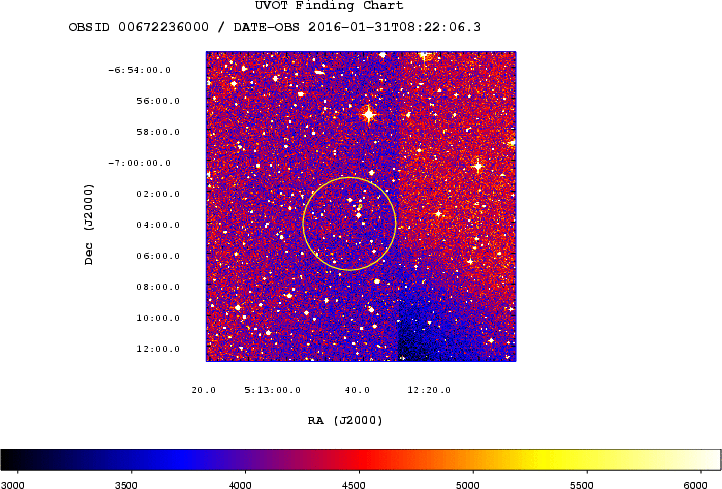
TITLE: GCN/SWIFT NOTICE
NOTICE_DATE: Sun 31 Jan 16 08:25:06 UT
NOTICE_TYPE: Swift-UVOT Source List
TRIGGER_NUM: 672236, Seg_Num: 0
POINT_RA: 78.207d {+05h 12m 50s} (J2000)
POINT_DEC: -7.056d {-07d 03' 22"} (J2000)
POINT_ROLL: 244.960d
IMG_START_DATE: 17418 TJD; 31 DOY; 16/01/31
IMG_START_TIME: 30110.49 SOD {08:21:50.49} UT, 78.5 [sec] since BAT Trigger Time
FILTER: 10, White
BKG_MEAN: 2.322
N_STARS: 49
X_OFFSET: 672 [pixels]
Y_OFFSET: 456 [pixels]
X_MAX: 1631 [pixels]
Y_MAX: 1415 [pixels]
DET_THRESH: 13
PHOTO_THRESH: 6
SL_URL: sw00672236000msufc0078.fits
SUN_POSTN: 313.34d {+20h 53m 22s} -17.50d {-17d 29' 57"}
SUN_DIST: 120.46 [deg] Sun_angle= -8.3 [hr] (East of Sun)
MOON_POSTN: 211.14d {+14h 04m 34s} -9.08d {-09d 04' 51"}
MOON_DIST: 130.22 [deg]
MOON_ILLUM: 58 [%]
GAL_COORDS: 207.90,-25.11 [deg] galactic lon,lat of the pointing direction
ECL_COORDS: 76.46,-29.94 [deg] ecliptic lon,lat of the pointing direction
COMMENTS: SWIFT-UVOT Source List.
TITLE: GCN/SWIFT NOTICE
NOTICE_DATE: Sun 31 Jan 16 08:26:40 UT
NOTICE_TYPE: Swift-UVOT Image
TRIGGER_NUM: 672236, Seg_Num: 0
POINT_RA: 78.207d {+05h 12m 50s} (J2000)
POINT_DEC: -7.056d {-07d 03' 22"} (J2000)
ROLL: 244.960d
IMG_START_DATE: 17418 TJD; 31 DOY; 16/01/31
IMG_START_TIME: 30110.49 SOD {08:21:50.49} UT, 78.5 [sec] since BAT Trigger Time
FILTER: 10, White
EXPOSURE_ID: 475921326
X_OFFSET: 1077 [pixels]
Y_OFFSET: 901 [pixels]
WIDTH: 160 [pixels]
HEIGHT: 160 [pixels]
X_GRB_POS: 1237
Y_GRB_POS: 1061
BINNING_INDEX: 1
IM_URL: sw00672236000msuni0094.fits
SUN_POSTN: 313.34d {+20h 53m 22s} -17.50d {-17d 29' 56"}
SUN_DIST: 120.46 [deg] Sun_angle= -8.3 [hr] (East of Sun)
MOON_POSTN: 211.15d {+14h 04m 37s} -9.08d {-09d 05' 03"}
MOON_DIST: 130.23 [deg]
MOON_ILLUM: 58 [%]
GAL_COORDS: 207.90,-25.11 [deg] galactic lon,lat of the pointing direction
ECL_COORDS: 76.46,-29.94 [deg] ecliptic lon,lat of the pointing direction
COMMENTS: SWIFT-UVOT Image.
COMMENTS: The GRB Position came from the XRT Position Command.
COMMENTS: The image has 2x2 binning (compression).
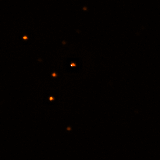
TITLE: GCN/SWIFT NOTICE
NOTICE_DATE: Sun 31 Jan 16 08:26:57 UT
NOTICE_TYPE: Swift-UVOT Processed Image
TRIGGER_NUM: 672236, Seg_Num: 0
POINT_RA: 78.207d {+05h 12m 50s} (J2000)
POINT_DEC: -7.056d {-07d 03' 22"} (J2000)
ROLL: 244.960d
IMG_START_DATE: 17418 TJD; 31 DOY; 16/01/31
IMG_START_TIME: 30110.49 SOD {08:21:50.49} UT, 78.5 [sec] since BAT Trigger Time
FILTER: 10, White
EXPOSURE_ID: 475921326
X_OFFSET: 1077 [pixels]
Y_OFFSET: 901 [pixels]
WIDTH: 160 [pixels]
HEIGHT: 160 [pixels]
X_GRB_POS: 1237
Y_GRB_POS: 1061
BINNING_INDEX: 1
IM_URL: sw00672236000msuni0094.fits
SUN_POSTN: 313.34d {+20h 53m 22s} -17.50d {-17d 29' 55"}
SUN_DIST: 120.46 [deg] Sun_angle= -8.3 [hr] (East of Sun)
MOON_POSTN: 211.16d {+14h 04m 37s} -9.09d {-09d 05' 06"}
MOON_DIST: 130.24 [deg]
MOON_ILLUM: 58 [%]
GAL_COORDS: 207.90,-25.11 [deg] galactic lon,lat of the pointing direction
ECL_COORDS: 76.46,-29.94 [deg] ecliptic lon,lat of the pointing direction
COMMENTS: SWIFT-UVOT Processed Image.
COMMENTS: The GRB Position came from the XRT Position Command.
COMMENTS: The image has 2x2 binning (compression).
COMMENTS: All 4 attachments are included.
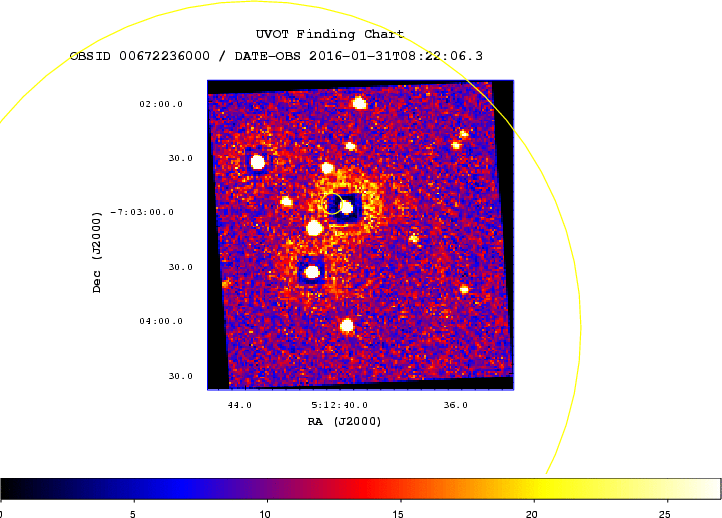
TITLE: GCN/SWIFT NOTICE
NOTICE_DATE: Sun 31 Jan 16 08:28:42 UT
NOTICE_TYPE: Swift-UVOT Position
TRIGGER_NUM: 672236, Seg_Num: 0
GRB_RA: 78.1680d {+05h 12m 40.32s} (J2000),
78.3632d {+05h 13m 27.17s} (current),
77.5613d {+05h 10m 14.70s} (1950)
GRB_DEC: -7.0497d {-07d 02' 58.9"} (J2000),
-7.0315d {-07d 01' 53.3"} (current),
-7.1082d {-07d 06' 29.6"} (1950)
GRB_ERROR: 0.6 [arcsec radius, statistical only]
GRB_MAG: 13.88 +/- 0.14 [mag]
FILTER: 10, White
IMG_START_DATE: 17418 TJD; 31 DOY; 16/01/31
IMG_START_TIME: 30108.00 SOD {08:21:48.00} UT, 76.0 [sec] since BAT Trigger Time
SUN_POSTN: 313.34d {+20h 53m 22s} -17.50d {-17d 29' 54"}
SUN_DIST: 120.42 [deg] Sun_angle= -8.3 [hr] (East of Sun)
MOON_POSTN: 211.17d {+14h 04m 41s} -9.09d {-09d 05' 20"}
MOON_DIST: 130.29 [deg]
MOON_ILLUM: 58 [%]
GAL_COORDS: 207.87,-25.15 [deg] galactic lon,lat of the burst (or transient)
ECL_COORDS: 76.42,-29.93 [deg] ecliptic lon,lat of the burst (or transient)
COMMENTS: SWIFT UVOT Position Notice.
COMMENTS: This Notice was ground-generated -- not flight-generated.
COMMENTS: The UVOT position is 7.6 arcsec from the XRT position.
COMMENTS: Result based on Genie data.
COMMENTS: Notice generated automatically.
TITLE: GCN/SWIFT NOTICE
NOTICE_DATE: Sun 31 Jan 16 08:31:39 UT
NOTICE_TYPE: Swift-UVOT Source List
TRIGGER_NUM: 672236, Seg_Num: 0
POINT_RA: 78.209d {+05h 12m 50s} (J2000)
POINT_DEC: -7.055d {-07d 03' 17"} (J2000)
POINT_ROLL: 244.959d
IMG_START_DATE: 17418 TJD; 31 DOY; 16/01/31
IMG_START_TIME: 30322.47 SOD {08:25:22.47} UT, 290.5 [sec] since BAT Trigger Time
FILTER: 7, U
BKG_MEAN: 0.773
N_STARS: 30
X_OFFSET: 757 [pixels]
Y_OFFSET: 581 [pixels]
X_MAX: 1716 [pixels]
Y_MAX: 1540 [pixels]
DET_THRESH: 8
PHOTO_THRESH: 3
SL_URL: sw00672236000msufc0290.fits
SUN_POSTN: 313.34d {+20h 53m 23s} -17.50d {-17d 29' 52"}
SUN_DIST: 120.46 [deg] Sun_angle= -8.3 [hr] (East of Sun)
MOON_POSTN: 211.19d {+14h 04m 46s} -9.10d {-09d 05' 44"}
MOON_DIST: 130.27 [deg]
MOON_ILLUM: 58 [%]
GAL_COORDS: 207.90,-25.11 [deg] galactic lon,lat of the pointing direction
ECL_COORDS: 76.47,-29.94 [deg] ecliptic lon,lat of the pointing direction
COMMENTS: SWIFT-UVOT Source List.
TITLE: GCN/SWIFT NOTICE
NOTICE_DATE: Sun 31 Jan 16 08:31:55 UT
NOTICE_TYPE: Swift-UVOT Processed Source List
TRIGGER_NUM: 672236, Seg_Num: 0
POINT_RA: 78.209d {+05h 12m 50s} (J2000)
POINT_DEC: -7.055d {-07d 03' 17"} (J2000)
POINT_ROLL: 244.959d
IMG_START_DATE: 17418 TJD; 31 DOY; 16/01/31
IMG_START_TIME: 30322.47 SOD {08:25:22.47} UT, 290.5 [sec] since BAT Trigger Time
FILTER: 7, U
BKG_MEAN: 0.773
N_STARS: 30
X_OFFSET: 757 [pixels]
Y_OFFSET: 581 [pixels]
X_MAX: 1716 [pixels]
Y_MAX: 1540 [pixels]
DET_THRESH: 8
PHOTO_THRESH: 3
SL_URL: sw00672236000msufc0290.fits
SUN_POSTN: 313.35d {+20h 53m 23s} -17.50d {-17d 29' 52"}
SUN_DIST: 120.46 [deg] Sun_angle= -8.3 [hr] (East of Sun)
MOON_POSTN: 211.20d {+14h 04m 47s} -9.10d {-09d 05' 46"}
MOON_DIST: 130.27 [deg]
MOON_ILLUM: 58 [%]
GAL_COORDS: 207.90,-25.11 [deg] galactic lon,lat of the pointing direction
ECL_COORDS: 76.47,-29.94 [deg] ecliptic lon,lat of the pointing direction
COMMENTS: SWIFT-UVOT Processed Source List.
COMMENTS: All 4 attachments are included.
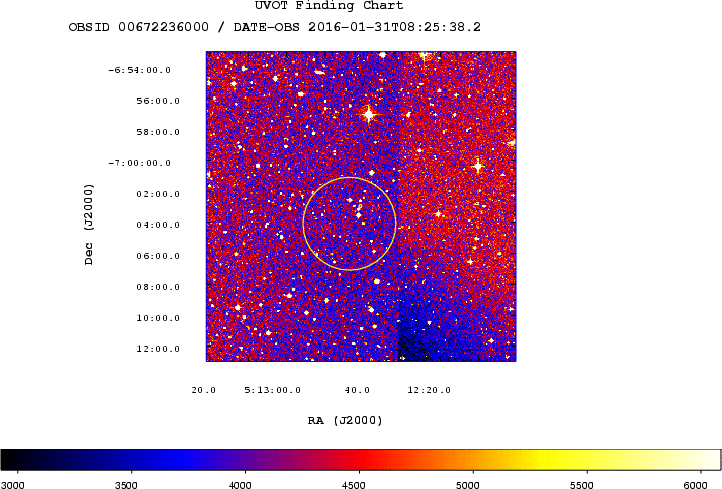
TITLE: GCN/SWIFT NOTICE
NOTICE_DATE: Sun 31 Jan 16 08:33:02 UT
NOTICE_TYPE: Swift-UVOT Image
TRIGGER_NUM: 672236, Seg_Num: 0
POINT_RA: 78.209d {+05h 12m 50s} (J2000)
POINT_DEC: -7.055d {-07d 03' 17"} (J2000)
ROLL: 244.959d
IMG_START_DATE: 17418 TJD; 31 DOY; 16/01/31
IMG_START_TIME: 30322.47 SOD {08:25:22.47} UT, 290.5 [sec] since BAT Trigger Time
FILTER: 7, U
EXPOSURE_ID: 475921538
X_OFFSET: 1077 [pixels]
Y_OFFSET: 901 [pixels]
WIDTH: 160 [pixels]
HEIGHT: 160 [pixels]
X_GRB_POS: 1237
Y_GRB_POS: 1061
BINNING_INDEX: 1
IM_URL: sw00672236000msuni0306.fits
SUN_POSTN: 313.35d {+20h 53m 23s} -17.50d {-17d 29' 51"}
SUN_DIST: 120.46 [deg] Sun_angle= -8.3 [hr] (East of Sun)
MOON_POSTN: 211.20d {+14h 04m 49s} -9.10d {-09d 05' 55"}
MOON_DIST: 130.28 [deg]
MOON_ILLUM: 58 [%]
GAL_COORDS: 207.90,-25.11 [deg] galactic lon,lat of the pointing direction
ECL_COORDS: 76.47,-29.94 [deg] ecliptic lon,lat of the pointing direction
COMMENTS: SWIFT-UVOT Image.
COMMENTS: The GRB Position came from the XRT Position Command.
COMMENTS: The image has 2x2 binning (compression).
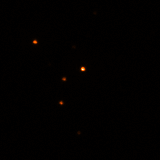
TITLE: GCN/SWIFT NOTICE
NOTICE_DATE: Sun 31 Jan 16 08:33:15 UT
NOTICE_TYPE: Swift-UVOT Processed Image
TRIGGER_NUM: 672236, Seg_Num: 0
POINT_RA: 78.209d {+05h 12m 50s} (J2000)
POINT_DEC: -7.055d {-07d 03' 17"} (J2000)
ROLL: 244.959d
IMG_START_DATE: 17418 TJD; 31 DOY; 16/01/31
IMG_START_TIME: 30322.47 SOD {08:25:22.47} UT, 290.5 [sec] since BAT Trigger Time
FILTER: 7, U
EXPOSURE_ID: 475921538
X_OFFSET: 1077 [pixels]
Y_OFFSET: 901 [pixels]
WIDTH: 160 [pixels]
HEIGHT: 160 [pixels]
X_GRB_POS: 1237
Y_GRB_POS: 1061
BINNING_INDEX: 1
IM_URL: sw00672236000msuni0306.fits
SUN_POSTN: 313.35d {+20h 53m 23s} -17.50d {-17d 29' 51"}
SUN_DIST: 120.46 [deg] Sun_angle= -8.3 [hr] (East of Sun)
MOON_POSTN: 211.21d {+14h 04m 50s} -9.10d {-09d 05' 57"}
MOON_DIST: 130.28 [deg]
MOON_ILLUM: 58 [%]
GAL_COORDS: 207.90,-25.11 [deg] galactic lon,lat of the pointing direction
ECL_COORDS: 76.47,-29.94 [deg] ecliptic lon,lat of the pointing direction
COMMENTS: SWIFT-UVOT Processed Image.
COMMENTS: The GRB Position came from the XRT Position Command.
COMMENTS: The image has 2x2 binning (compression).
COMMENTS: All 4 attachments are included.
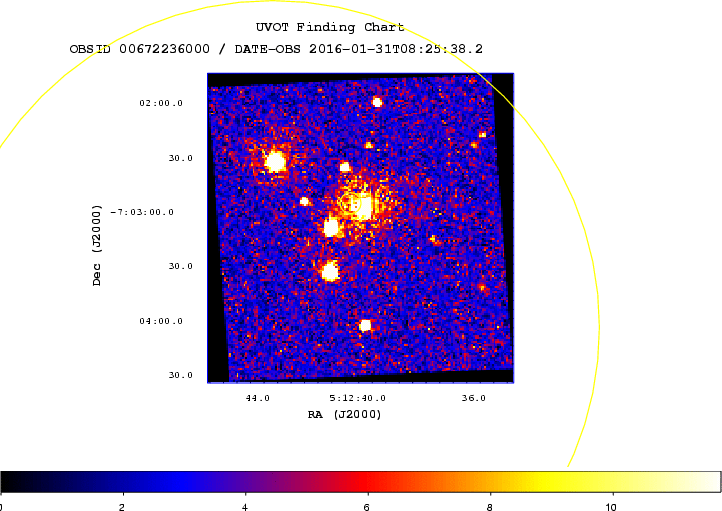
RA(J2000) = 05h 12m 44s Dec(J2000) = -07d 04' 02"with an uncertainty of 3 arcmin (radius, 90% containment, including systematic uncertainty). The BAT light curve shows a large FRED-like peak structure with a duration of about 100 sec. The peak count rate was ~8100 counts/sec (15-350 keV), at ~16 sec after the trigger.
RA(J2000) = +05h 12m 40.80s Dec(J2000) = -07d 02' 56.0"with an uncertainty of 4.7 arcseconds (radius, 90% containment). This location is 77 arcseconds from the BAT onboard position, within the BAT error circle. No event data are yet available to determine the column density using X-ray spectroscopy.
RA(J2000) = 05:12:40.34 = 78.16810 DEC(J2000) = -07:02:59.1 = -7.04975with a 90%-confidence error radius of about 0.61 arc sec. This position is 7.5 arc sec. from the center of the XRT error circle. The estimated magnitude is 13.88 with a 1-sigma error of about 0.14. No correction has been made for the expected extinction corresponding to E(B-V) of 0.11.
T-Tmid Date Time Expt. Ra Dec Mag
---------|---------------------|-------|-----------------|-----------------|------
5210 2016-01-31 09:46:52 60 (05h 12m 40.36s , -07d 02m 58.5s) +15.55
The 5-sigma upper limit has been about 16.7mag
The message may be cited.
r =3D 13.35 =B1 0.04 i =3D 13.01 =B1 0.02 z =3D 12.67 =B1 0.04These magnitudes are in the AB system and are not corrected for Galactic extinction in the direction of the GRB.
m(I) = 16.05 +/- 0.02 m(R) = 16.56 +/- 0.02 m(V) = 17.07 +/- 0.02 m(B) = 17.59 +/- 0.02calibrated with four SDSS stars in the field.
RA (J2000): 05h 12m 40.31s Dec (J2000): -07d 02' 59.6"with an uncertainty of 2.2 arcsec (radius, 90% confidence).
RA(J2000) = 05h 12m 40.8s Dec(J2000) = -07d 02' 13.0"with an uncertainty of 1.1 arcmin, (radius, sys+stat, 90% containment). The partial coding was 64%.
Tmid(s)+T0 Filter Exp. time Mag Mag. Err. 6197 V 300s 15.05 0.04 6796 V 300s 15.17 0.04 7395 V 300s 15.28 0.04T17 observations
Tmid(s)+T0 Filter Exp. time Mag Mag. Err. 6651 R 4x300s 15.71 0.02 7946 R 4x300s 15.96 0.02 11649 R 4x300s 16.56 0.03 12952 R 4x300s 16.68 0.03 14244 R 4x300s 16.86 0.04 15709 R 4x300s 16.99 0.04T9 observations
Tmid(s)+T0 Filter Exp. time Mag Mag. Err. 14761 V 5x120s 16.27 0.34 15454 V 5x120s 16.43 0.37 16190 V 5x120s 16.55 0.42 17083 V 5x120s 16.55 0.44 17767 V 5x120s 16.59 0.43 18452 V 5x120s 16.65 0.48 19179 V 5x120s 16.70 0.54 20295 V 5x120s 16.75 0.56
Date UT start t-T0 Filter Exp. OT Err
(mid, days) (s)
2016-01-31 11:14:41 0.12106 20 16.43 0.10
2016-01-31 11:27:26 0.13015 60 16.49 0.04
2016-01-31 11:28:30 0.13089 60 16.51 0.04
2016-01-31 11:29:35 0.13164 60 16.50 0.04
2016-01-31 11:30:39 0.13238 60 16.52 0.05
2016-01-31 11:31:43 0.13388 60 16.61 0.05
2016-01-31 11:33:52 0.13462 60 16.46 0.04
2016-01-31 11:34:57 0.13537 60 16.53 0.05
2016-01-31 11:36:01 0.13611 60 16.58 0.05
2016-01-31 11:37:06 0.13686 60 16.62 0.05
2016-01-31 11:38:10 0.13760 60 16.56 0.04
2016-01-31 11:39:14 0.13834 60 16.58 0.04
2016-01-31 11:40:18 0.13909 60 16.57 0.04
Photometry is based on nearby USNO B1.0 stars, R2 magnitude.
Total column: 2.56 (+0.31, -0.29) x 10^21 cm^-2 Galactic foreground: 1.1 x 10^21 cm^-2 Excess significance: 7.9 sigma Photon index: 2.10 (+/-0.08)If the light curve continues to decay with a power-law decay index of 1.09, the count rate at T+24 hours will be 0.053 count s^-1, corresponding to an observed (unabsorbed) 0.3-10 keV flux of 1.8 x 10^-12 (2.8 x 10^-12) erg cm^-2 s^-1.
------------------------------------
JD Mag Filter SNR
------------------------------------
2457419.24025 17.360 CR 14.34
2457419.26062 17.241 CR 9.74
2457419.24025 17.671 CV 14.40
2457419.26062 17.498 CV 9.74
-------------------------------------
The images are available at:
http://www.osservatoriobassano.org/GRB.asp
RA (J2000.0) = 05 h 12 m 40.32 s Dec. (J2000.0) = -07d 02' 58.92with an uncertainty of 0.5" in each coordinate.
g' = 18.7 +/- 0.05 mag, r' = 18.4 +/- 0.05 mag, i' = 18.3 +/- 0.05 mag, z' = 18.2 +/- 0.05 mag, J = 17.7 +/- 0.1 mag, H = 17.6 +/- 0.1 mag, and K = 17.1 +/- 0.1 mag.Given magnitudes are calibrated against GROND zeropoints as well as 2MASS field stars and are not corrected for the expected Galactic foreground extinction corresponding to a reddening of E_(B-V)=0.09 mag in the direction of the burst (Schlafly & Finkbeiner 2011).
#T0+[day] MID-UT T-EXP[sec] g' g'_err Rc Rc_err Ic Ic_err ----------------------------------------------------------------------- 0.24373 14:11:29 540.0 17.92 0.09 17.19 0.05 16.88 0.06 ----------------------------------------------------------------------- T0+ : Elapsed time after the burst [day] T-EXP: Total Exposure time [sec]
RA (J2000) = 05:12:40.33 = 78.16804 (deg.)
Dec (J2000) = -07:02:58.81 = -7.04967 (deg.)
with an estimated uncertainty of 0.43 arc sec. (radius, 90% confidence).
Filter T_start(s) T_stop(s) Exp(s) Mag white_fc 78 228 147 13.77+-1.10 white 5051 11361 1081 16.71+-0.02 v 4026 5662 393 15.72+-0.03 b 4846 10449 1138 16.81+-0.02 u 290 540 245 13.08+-0.03 u 4641 6277 393 15.64+-0.03 uvw1 4436 6072 393 16.18+-0.04 uvm2 4231 5867 393 16.64+-0.06 uvw2 3821 12083 1098 17.43+-0.05The magnitudes in the table are not corrected for the Galactic extinction due to the reddening of E(B-V) = 0.11 in the direction of the burst (Schlegel et al. 1998).
Date UT start t-T0 Filter Exp. OT Err.
(mid, days) (s)
2016-02-01 13:01:56 1.19543 R 1*120 19.40 0.08
USNO-B.1_id R2 0829-0078223 15.70 0829-0078147 14.56 0828-0074893 14.88 0828-0074768 14.81
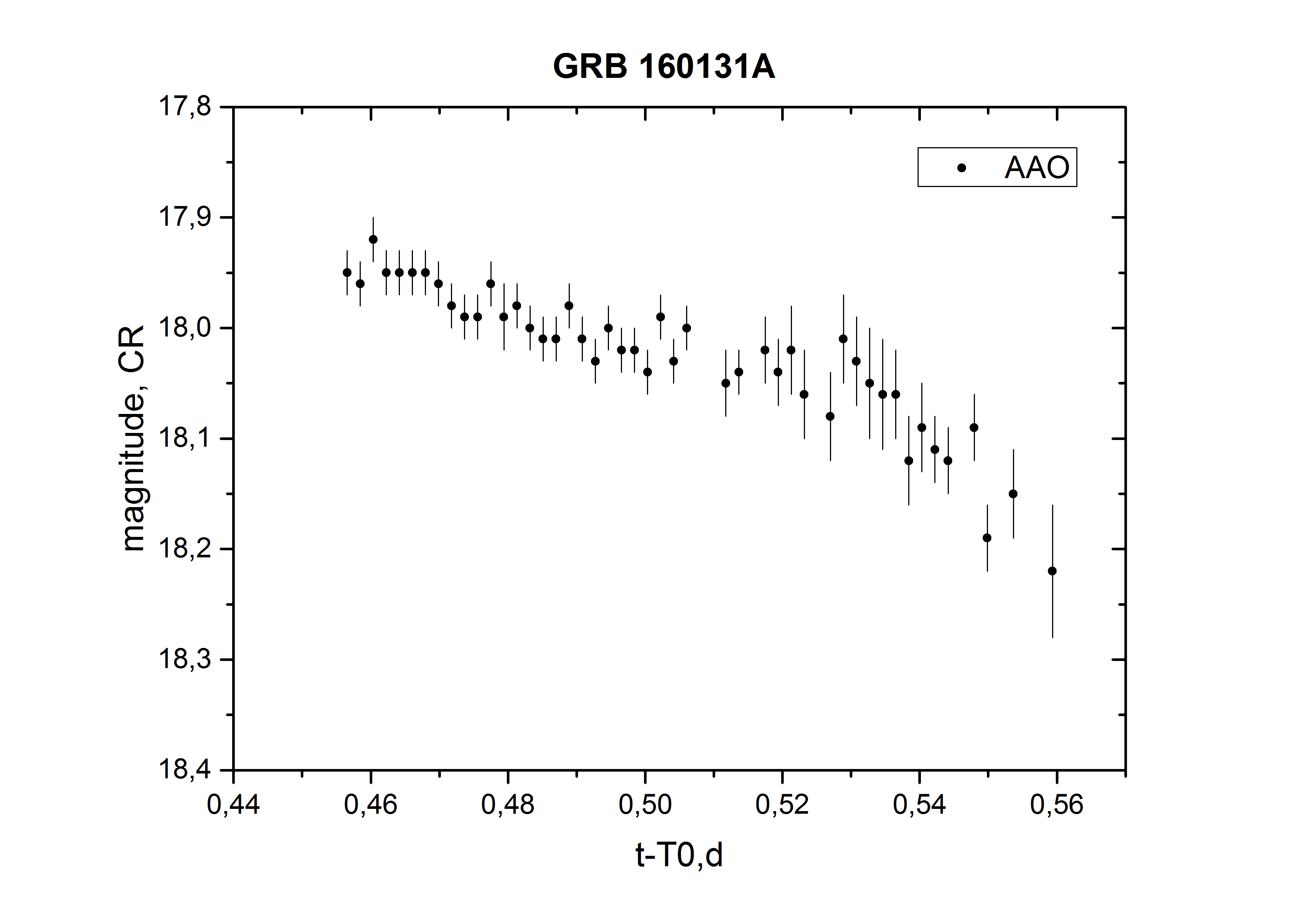
RA = 15:12:40.351 +/- 0.001 Dec = -07:02:58.80 +/- 0.02consistent with the enhanced Swift/XRT position (Goad et al.; GCN 18958) and the optical position (Page & Barthelmy.; GCN 18951, Yurkov et al.; GCN 18952). Follow-up observations are planned. We thank the VLA staff for rapidly scheduling these observations."
RA = 05:12:40.351 +/- 0.001 Dec = -07:02:58.80 +/- 0.02Thanks to Frank Marshall for pointing out the error."
r =3D 21.64 +/- 0.05 i =3D 21.41 +/- 0.03 z > 20.48These magnitudes are in the AB system and are not corrected for Galactic extinction in the direction of the GRB. We note that there is a faint, possible source present in the DSS near this source which could be the GRB host galaxy.
Date UT start t-T0 Filter Exp. OT Err.
(mid, days) (s)
2016-02-04 11:42:43 4.16058 R 29*120 21.70 0.23
USNO-B.1_id R2
0829-0078147 14.56
0829-0078222 18.96
0829-0078226 18.69
0829-0078129 17.62
Date UT start t-T0 Filter Exp. OT Err.
(mid, days) (s)
2016-02-05 14:22:45 5.28802 R 21*300 22.40 0.20
Photometry is based on nearby USNO-B1.0 stars
USNO-B.1_id R2 0829-0078223 15.70 0829-0078147 14.56 0829-0078167 17.71 0829-0078222 18.96 0829-0078226 18.69 0829-0078129 17.62
Date UT start t-T0 Filter Exp. OT Err.
(mid, days) (s)
2016-02-06 13:45:54 6.26762 R 21*300 22.40 0.3
2016-02-07 13:30:04 7.25330 R 21*300 >22.40 (3sigma)
Photometry is based on nearby USNO-B1.0 stars
0829-0078223 15.70 0829-0078147 14.56 0829-0078167 17.71 0829-0078222 18.96 0829-0078226 18.69 0829-0078129 17.62